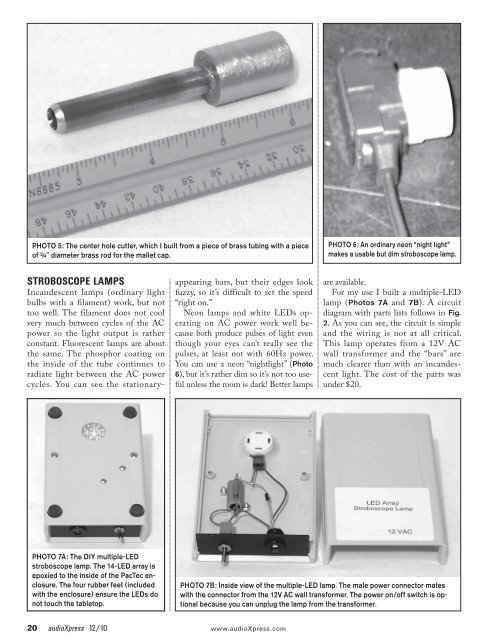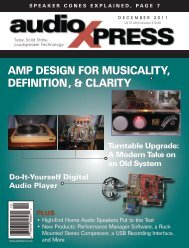A TUNE-UP FOR THE DUAL TURNTABLE - ThaiHDbox
A TUNE-UP FOR THE DUAL TURNTABLE - ThaiHDbox
A TUNE-UP FOR THE DUAL TURNTABLE - ThaiHDbox
You also want an ePaper? Increase the reach of your titles
YUMPU automatically turns print PDFs into web optimized ePapers that Google loves.
PHOTO 5: The center hole cutter, which I built from a piece of brass tubing with a piece<br />
of ¾� diameter brass rod for the mallet cap.<br />
STROBOSCOPE LAMPS<br />
Incandescent lamps (ordinary light<br />
bulbs with a filament) work, but not<br />
too well. The filament does not cool<br />
very much between cycles of the AC<br />
power so the light output is rather<br />
constant. Fluorescent lamps are about<br />
the same. The phosphor coating on<br />
the inside of the tube continues to<br />
radiate light between the AC power<br />
cycles. You can see the stationary-<br />
PHOTO 7A: The DIY multiple-LED<br />
stroboscope lamp. The 14-LED array is<br />
epoxied to the inside of the PacTec enclosure.<br />
The four rubber feet (included<br />
with the enclosure) ensure the LEDs do<br />
not touch the tabletop.<br />
appearing bars, but their edges look<br />
fuzzy, so it’s difficult to set the speed<br />
“right on.”<br />
Neon lamps and white LEDs operating<br />
on AC power work well because<br />
both produce pulses of light even<br />
though your eyes can’t really see the<br />
pulses, at least not with 60Hz power.<br />
You can use a neon “nightlight” (Photo<br />
6), but it’s rather dim so it’s not too useful<br />
unless the room is dark! Better lamps<br />
20 audioXpress 12/10 www.audioXpress.com<br />
PHOTO 6: An ordinary neon “night light”<br />
makes a usable but dim stroboscope lamp.<br />
are available.<br />
For my use I built a multiple-LED<br />
lamp (Photos 7A and 7B). A circuit<br />
diagram with parts lists follows in Fig.<br />
2. As you can see, the circuit is simple<br />
and the wiring is not at all critical.<br />
This lamp operates from a 12V AC<br />
wall transformer and the “bars” are<br />
much clearer than with an incandescent<br />
light. The cost of the parts was<br />
under $20.<br />
PHOTO 7B: Inside view of the multiple-LED lamp. The male power connector mates<br />
with the connector from the 12V AC wall transformer. The power on/off switch is optional<br />
because you can unplug the lamp from the transformer.



